| dc.description.abstract | The topic of this research was “The New Performance Appraisal Scheme (NPAS) and Employee
Performance in Local Governments in Uganda, A Case Study of Arua Municipal Council Local Government.
The overall objective was to examine how the New Performance Appraisal Scheme is being used to improve employee performance in Arua Municipal Council Local Government. The specific objectives were; to analyse how the NPAS is being used as a tool to motivate staff in Arua Municipal Council Local Government, to determine how performance feedback is used to improve employee performance in Arua Municipal Council Local Government, and to identify the challenges faced in implementing the NPAS in Arua Municipal Local Government.
The study adopted a case study design; while quantitative and qualitative approaches were employed in the collection and analysis of the data. The findings show that Arua Municipal Council uses the NPAS as basis for motivation of staff in confirmation, promotion, transfer, disciplining and training of staff among others. It also revealed that feedback was being used to motivate, give focus and direction on how well subordinates were performing, feedback from supervisors improves subordinates’ performance through demonstration of work instruments and guidelines. The basis of feedback was the setting of performance objectives as most staff set performance objectives at the beginning of every appraisal period. The objectives in turn are used by staff to fill appraisal forms from where after assessment; recommendations and interventions such as mentoring, couching, and training to fill performance gaps identified can be brought forward to improve performance. The study revealed the following, in the order of their listing, as the major constraints in the implementation of the NPAS; inadequate resources, too much work load and time consuming exercise, low level of training, rating errors/bias, form design being difficult to comprehend, lack of timely availability of the forms, and ‘who qualifies to appraise who’.
It was therefore concluded that in Arua Municipal Council, some effort has been attempted to
use the NPAS to improve employee performance through tagging rewards such as training,
promotion, assignment of responsibilities to the performance of staff, use of performance
feedback to recommend mechanisms for improvement. However these efforts have been
constrained by the limited number of incentives or rewards, non compliance of most staff to
procedure and processes of implementation of NPAS.
It was then recommended that both the council and line ministry (MoPS) should widen reward base to insure that excellent and good performance under the scheme are rewarded, that periodic training be organized for all the staff on NPAS so as to conceptualise the core principles involved; namely ROM and setting of performance indicators, outputs and targets, and that sanction be imposed on non compliant officers and appropriate disciplinary measures taken. The researcher suggested a special study to be carried out to examine the challenges of implementing the NPAS in Teaching Service as this study excluded the teachers and a comparative analysis of the implementation of the NPAS between some local governments or local governments and selected Ministries as areas for further research. | en_US |


